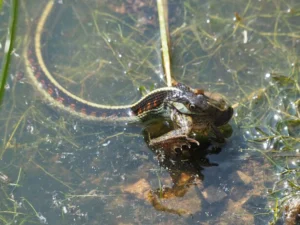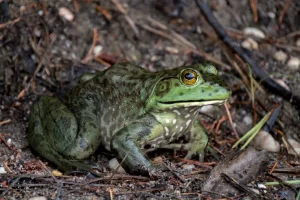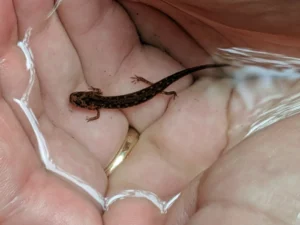Salamanders are small, soft-bodied animals that live in damp forests, shallow streams, wetlands, and wet soil. They are quiet, careful, and spend most of their time hiding. Because they are small and soft, many bigger animals see them as easy meals.
Salamanders are hunted by a wide range of predators, including birds, snakes, fish, mammals, frogs, and even other salamanders. Which predators come after them depends on the salamander’s size, species, and where it lives.
Why Are Salamanders So Vulnerable?
Salamanders have soft, moist skin that must stay wet for them to breathe. This keeps them in damp places like under leaves, inside rotting logs, or near water.

They move slowly, do not make noise, and lack strong defenses like claws or sharp teeth. This means they cannot fight back against most animals that hunt them.
Their main tools for survival are:
- Camouflage
- Staying hidden
- Escaping quickly
- Shedding their tails when grabbed
Even with these tricks, many still fall prey to bigger animals.
Birds That Hunt Salamanders
Birds are one of the most common predators of salamanders.
Many birds search through leaf litter or wet soil for small animals. If they spot movement, they strike quickly.
Common bird predators include:
- Herons and egrets, which wade through streams
- Crows and ravens, which hunt in forests
- Owls, which hunt at night
- Hawks, which scan from trees
- Jays and robins, which forage in leaf litter
Some birds even learn where salamanders hide and return to the same spots again and again.
Snakes That Eat Salamanders
Many snakes hunt and eat salamanders.
Because snakes and salamanders often live in the same damp areas, snakes often come across salamanders while hunting.

Snakes that commonly eat salamanders include:
- Garter snakes
- Ring-necked snakes
- Water snakes
- Green snakes
- Coral snakes (in some areas)
Snakes strike quickly, swallow their prey whole, and digest it slowly. Some snakes focus mainly on amphibians and are very skilled at finding them.
Fish That Feed on Salamanders
Young or aquatic salamanders are often eaten by fish.
In streams, rivers, and ponds, fish use sight and smell to find salamanders swimming or resting near the bottom.
Common fish predators include:
- Trout
- Bass
- Pike
- Sunfish
- Catfish
Even salamander larvae, with their small bodies and visible gills, are often picked off. To avoid being eaten, some aquatic salamanders hide under rocks or bury themselves in mud.
Mammals That Eat Salamanders
Many mammals hunt or scavenge for salamanders, especially in forests or near water.
These animals use smell, digging, or scratching to uncover salamanders hiding under logs or rocks.
Mammals that eat salamanders include:
- Raccoons, which search streams and logs
- Shrews, which dig and hunt for insects and amphibians
- Skunks, which root through leaves
- Opossums, which eat many kinds of small prey
- Foxes, which hunt at night
- Bears, which may dig for them in wet soil
Even small rodents may bite salamanders if they are hungry or curious.
Frogs and Other Amphibians
Larger frogs will sometimes eat salamanders, especially young or small ones.
Bullfrogs, in particular, are known to eat almost anything that fits in their mouths.

Other amphibians that may eat salamanders include:
- Toads, which snap at moving prey
- Larger salamanders, which sometimes eat smaller ones
- Newts, which may attack juveniles or larvae
In crowded ponds or tanks, cannibalism can be a real problem.
Insects and Invertebrates
Although insects are usually prey for salamanders, some larger ones will strike back.
Certain insects and invertebrates may attack or eat salamander larvae, including:
- Dragonfly larvae
- Giant water bugs
- Predatory beetles
- Leeches
- Spiders, in some cases
These predators are most dangerous during the larval stage, when the salamander is small, weak, and without strong limbs.
Humans as Salamander Predators
People are not natural predators of salamanders, but humans have a big impact.
Salamanders are sometimes caught for:
- The pet trade
- Scientific research
- Fishing bait
More often, humans harm salamanders indirectly, such as:
- Polluting streams and soil
- Draining wetlands
- Cutting down forests
- Introducing non-native predators
- Building roads and houses through their homes
These changes can kill salamanders or make it easier for other animals to catch them.
How Do Salamanders Avoid Predators?
Because so many animals hunt them, salamanders use several survival strategies.
Camouflage
Their skin often matches leaves, dirt, or moss, helping them blend in.
Hiding
They stay under logs, inside crevices, or buried in soil during the day.
Quick escapes
If spotted, they often dart away quickly, using their long tails to push off.
Tail loss
Many salamanders can drop their tail if grabbed. The tail wriggles to distract the predator while the salamander escapes.
Toxic skin
Some species have glands that release toxins. These make them taste bad or cause mild sickness in predators.
Warning colors
Bright colors, like orange or red, sometimes warn predators that the salamander is toxic.
These tools are not always enough, but they give salamanders a better chance to survive.
Which Salamanders Have the Most Predators?
Smaller salamanders have more predators because they are easier to catch and eat.

Juvenile salamanders and larvae are most at risk. They have fewer defenses, are easier to see, and are often found in groups.
Salamanders that live in open water or areas without much cover are also more vulnerable.
In contrast, larger salamanders that live underground or in deep water may avoid many predators just by staying hidden.
Do Salamanders Fight Back?
Salamanders rarely fight predators directly. They do not have claws, strong jaws, or fast attacks.
Their main goal is to avoid being seen and escape quickly if spotted.
However, some salamanders produce strong toxins that can cause:
- A bitter taste
- Numbness in the mouth
- Muscle weakness
- Nausea or vomiting in predators
This is usually enough to teach a predator to leave them alone in the future.
Can Salamanders Survive Without Predators?
No. Predators play an important role in nature, even for salamanders.
Predators help keep salamander numbers balanced. This prevents overpopulation and makes sure only the strongest survive and reproduce.
Without predators, salamanders might eat too many insects or crowd out other animals.
Healthy ecosystems need both prey and predators. Each group shapes the other over time.
Conclusion
Salamanders have many predators. Birds, snakes, fish, frogs, mammals, insects, and even other salamanders all hunt them.
Because they are small, soft, and slow, salamanders rely on camouflage, hiding, quick escapes, and toxic skin to survive.
Even with these defenses, they are often caught and eaten. Still, this is part of the natural cycle in the forests, streams, and wetlands they call home.
Hi, my name is Ezra Mushala, i have been interested animals all my life. I am the main author and editor here at snakeinformer.com.

